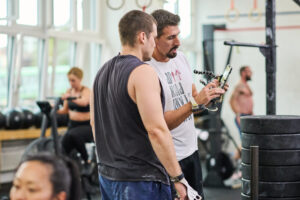
If you’re looking to get fit, lose weight, or simply shake up your routine, you might find yourself torn between two popular fitness options: bootcamp and CrossFit. At first glance, they might seem similar—both involve high-intensity training, group classes, and coaches leading the way. But once you scratch the surface, you’ll notice some fundamental differences that can impact your long-term results, motivation, and even injury risk.
In this article, we’ll explore the key differences between bootcamp and CrossFit, break down what to expect in each, and help you decide which one is right for your goals and lifestyle.
What is Bootcamp?
A bootcamp is typically a high-intensity group workout class inspired by military training. It usually involves bodyweight exercises, cardiovascular drills, plyometrics, and functional movements designed to get your heart rate up and burn calories. Most bootcamp classes are held in group settings—either in a gym, a park, or an outdoor space—and are designed for people of all fitness levels.
The structure of a bootcamp is often circuit-style: you rotate through various stations with minimal rest in between. You might do squats, push-ups, burpees, jumping jacks, and sprint drills, all in one session. The focus is on conditioning and endurance.
Unlike CrossFit, bootcamps do not follow universal movement standards. This means how a squat or push-up is performed can vary greatly between instructors and classes. While this can offer flexibility, it may also lead to inconsistencies in technique and limit measurable progress. (For more on the importance of consistent movement standards, check out our recent blog post here.)
What is CrossFit?
CrossFit is a branded fitness methodology that combines elements of weightlifting, gymnastics, and metabolic conditioning. CrossFit workouts are known as WODs (Workout of the Day) and are typically short, intense, and varied. A CrossFit class usually includes a warm-up, skill or strength training (such as deadlifts or pull-ups), followed by the WOD, and then a cooldown.
CrossFit emphasizes measurable progress. You’re encouraged to track your lifts, benchmark workouts, and improvements over time. The community aspect is also a strong part of the culture—you’ll likely find a close-knit, supportive group that pushes each other to improve.
Key Differences Between Bootcamp and CrossFit
While both bootcamp and CrossFit will get you sweating, here’s how they differ:
1. Equipment and Movements
- Bootcamp: Generally relies on minimal equipment. Expect bodyweight movements, resistance bands, medicine balls, or light dumbbells.
- CrossFit: Involves barbells, kettlebells, rowing machines, pull-up rigs, boxes, ropes, and more. Movements include Olympic lifts, advanced gymnastics, and powerlifting.
2. Programming and Progression
- Bootcamp: Classes are often stand-alone sessions. There may be little to no long-term progression built into the programming.
- CrossFit: Programming includes built-in progression through making movements more challenging, adding weight, increasing speed, or upping repetitions as the participant’s fitness level improves.
3. Intensity and Scalability
- Bootcamp: High-intensity, but often designed to be accessible to beginners. Movements are typically simpler and easier to scale.
- CrossFit: Designed to be accessible for everyone regardless of age or fitness level. Every movement can be scaled, and CrossFit is inclusive of people with disabilities. While the workouts can be intense and technical, they are adaptable to suit individual needs and abilities.
4. Coaching and Community
- Bootcamp: Coaching varies by instructor. It’s more about motivation and keeping the energy high.
- CrossFit: Coaches are certified and trained to teach proper technique in complex lifts and movements. There’s often a strong community culture.
5. Goals and Outcomes
- Bootcamp: Great for general fitness and cardiovascular endurance.
- CrossFit: Focuses on overall athleticism—strength, power, endurance, agility, and coordination. Also supports body composition changes through muscle development, which helps reduce body fat and enhance body formation.
Which One Is Right for You?
Choosing between a bootcamp and CrossFit depends on your personality, goals, and current fitness level.
Choose Bootcamp if:
- You want a fun, fast-paced workout that doesn’t require complex equipment or skills.
- You’re new to fitness and want to build a solid foundation.
- You prefer a cardio-heavy workout.
- You enjoy outdoor workouts or a lower-commitment environment.
Choose CrossFit if:
- You want to gain strength, learn new skills, and challenge yourself physically and mentally.
- You enjoy tracking progress and seeing tangible improvements.
- You’re interested in learning barbell lifts or bodyweight skills like pull-ups and handstands.
- You thrive in a supportive, tight-knit community.
Final Thoughts
Both bootcamp and CrossFit offer fantastic ways to get in shape and stay active. Bootcamp is a great entry point for many people—it’s simple, effective, and doesn’t require any prior experience. CrossFit, on the other hand, offers a more structured path to developing athleticism and strength, with an emphasis on long-term progress.
Ultimately, the best fitness program is the one you enjoy and can stick with consistently. Whether you choose the energy and simplicity of bootcamp, or the technical challenges and community of CrossFit, what matters most is that you show up, work hard, and stay committed to your health.
Still unsure? Try both and see what feels right for your body, mind, and goals. There’s no one-size-fits-all in fitness—and that’s the beauty of it.




